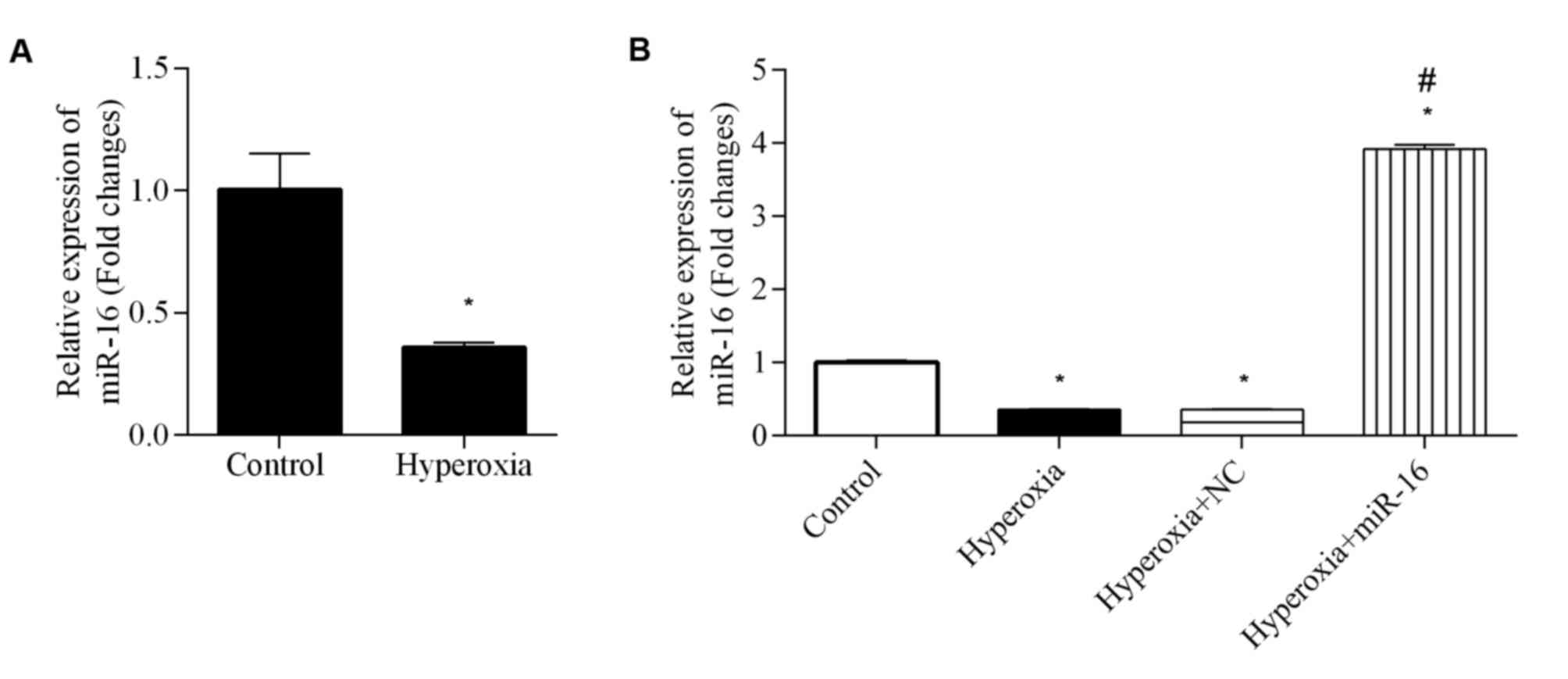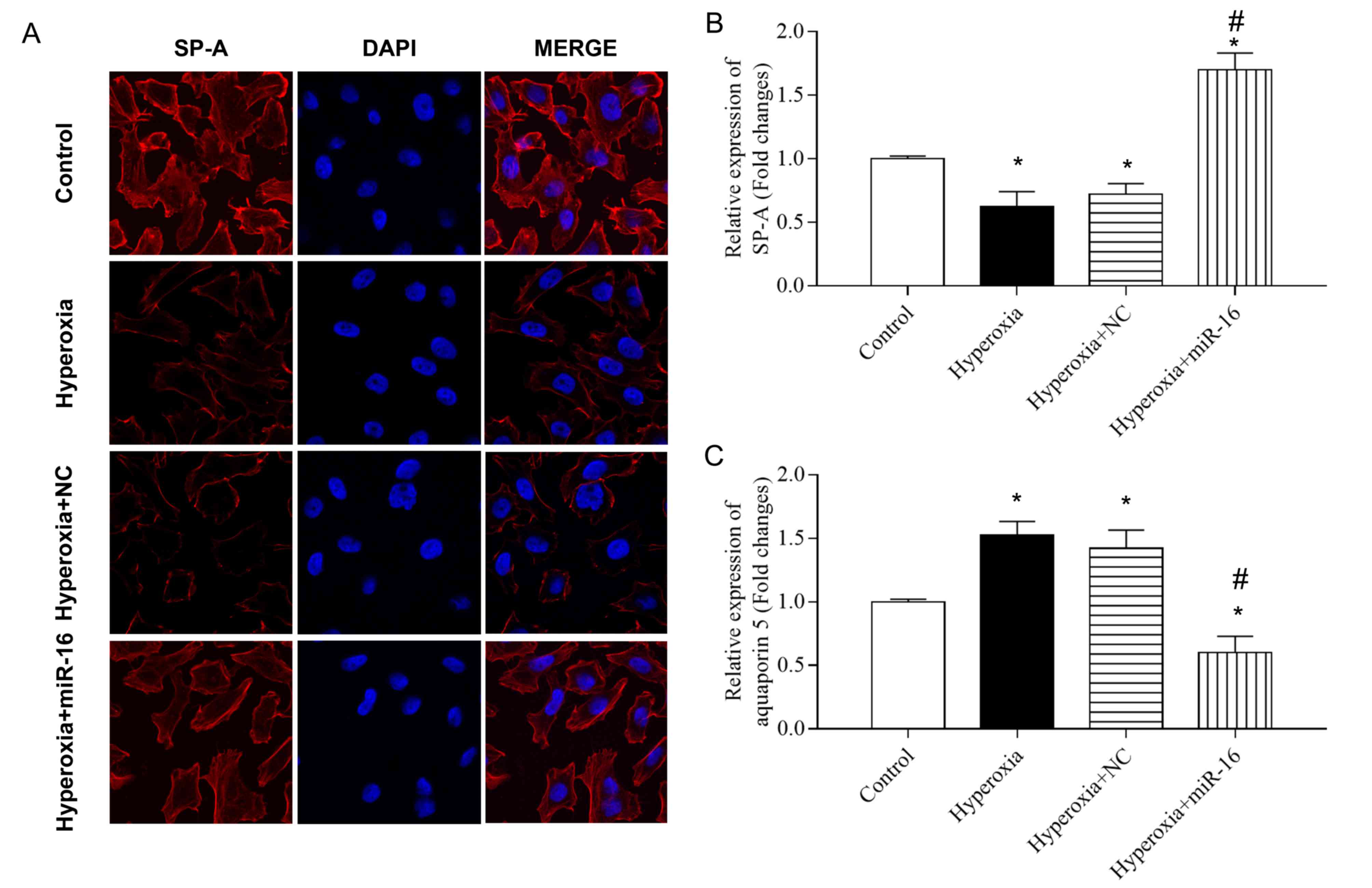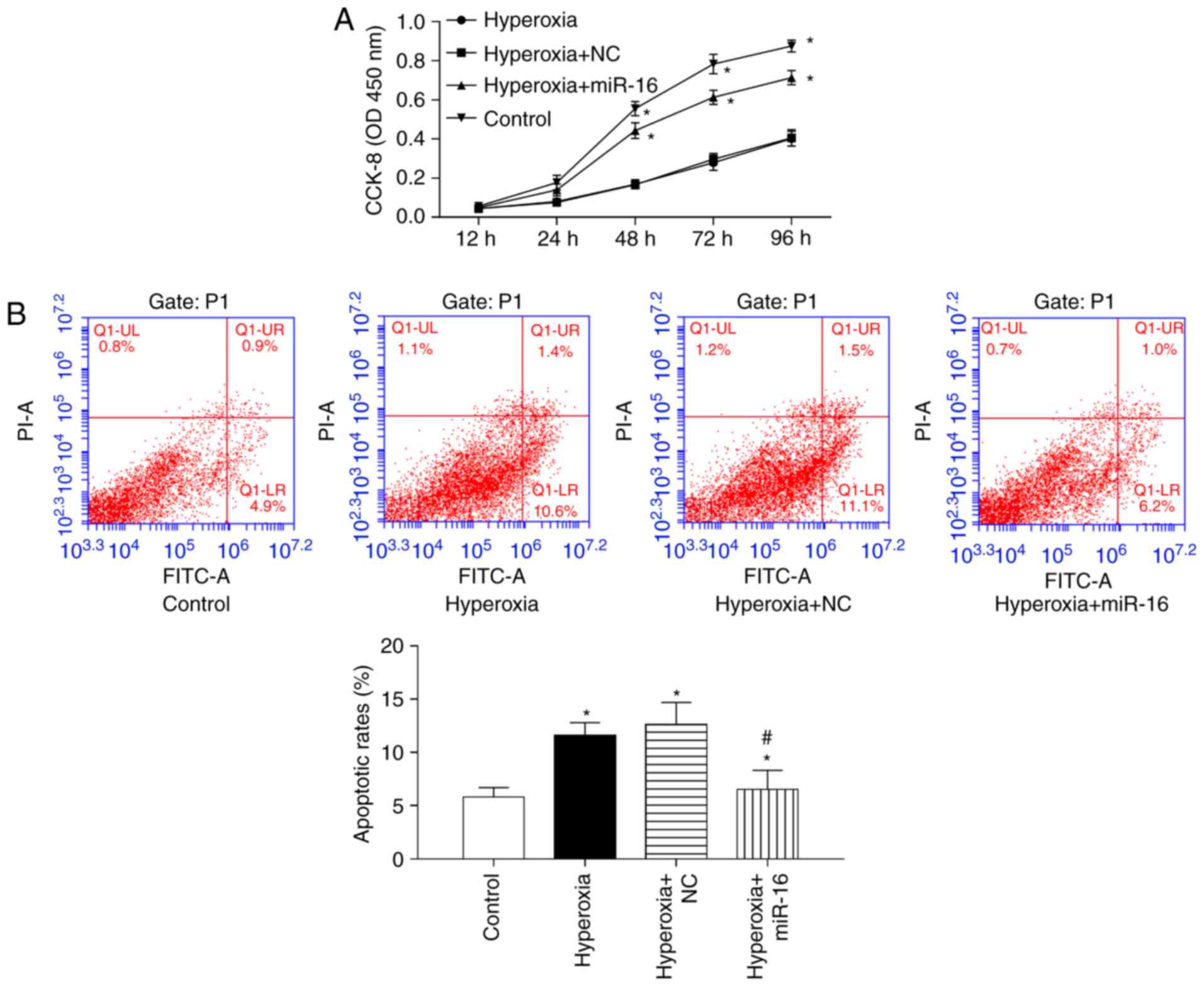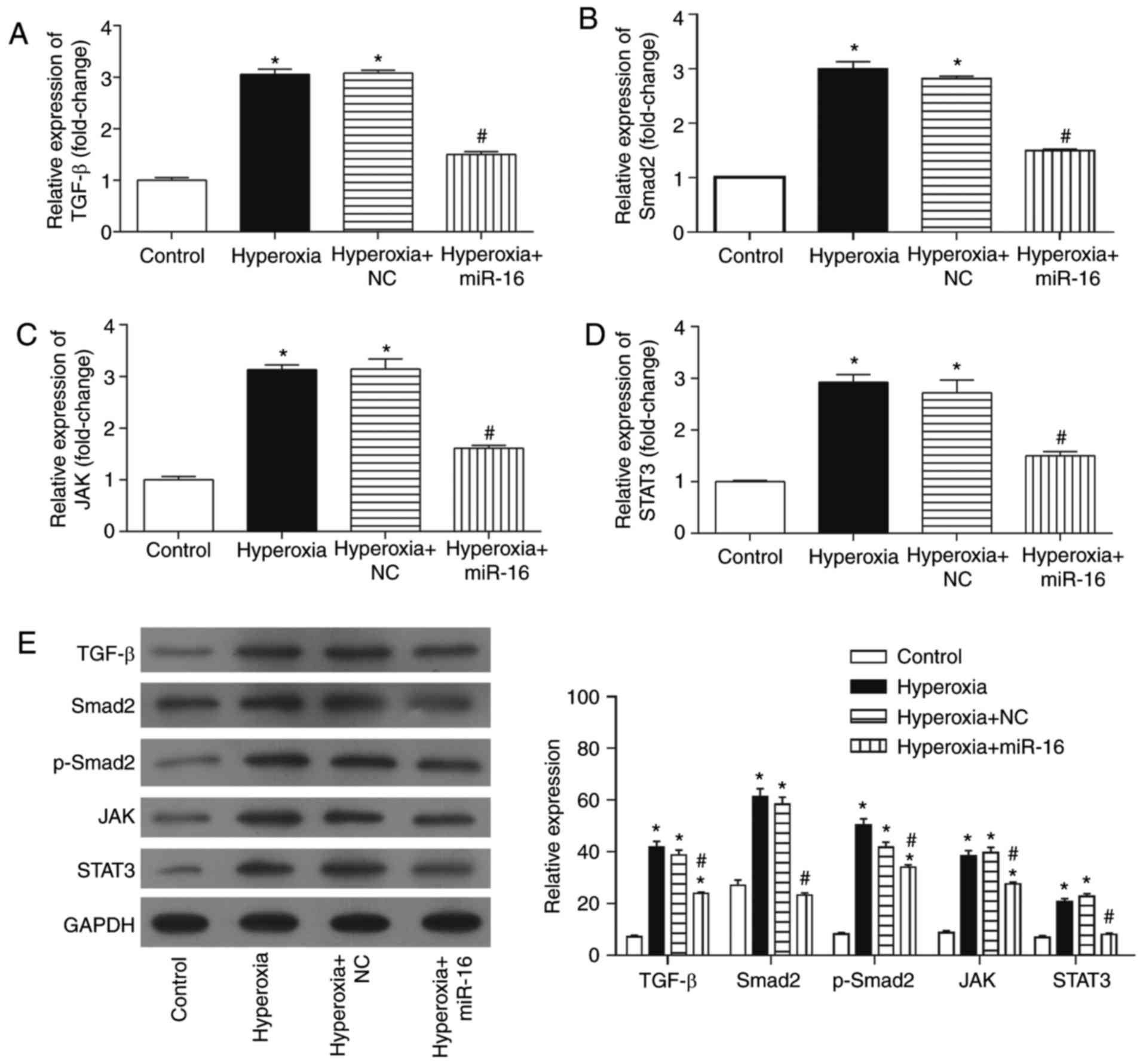|
1
|
Pittet JF, Griffiths MJ, Geiser T,
Kaminski N, Dalton SL, Huang X, Brown LA, Gotwals PJ, Koteliansky
VE, Matthay MA and Sheppard D: TGF-beta is a critical mediator of
acute lung injury. J Clin Invest. 107:1537–1544. 2001. View Article : Google Scholar : PubMed/NCBI
|
|
2
|
Kallet RH and Matthay MA: Hyperoxic acute
lung injury. Respir Care. 58:123–141. 2013. View Article : Google Scholar : PubMed/NCBI
|
|
3
|
Bellani G, Laffey JG, Pham T, Fan E,
Brochard L, Esteban A, Gattinoni L, van Haren F, Larsson A, McAuley
DF, et al: Epidemiology, patterns of care, and mortality for
patients with acute respiratory distress syndrome in intensive care
units in 50 countries. JAMA. 315:788–800. 2016. View Article : Google Scholar : PubMed/NCBI
|
|
4
|
Fu H, Zhang T, Huang R, Yang Z, Liu C, Li
M, Fang F and Xu F: Calcitonin gene-related peptide protects type
II alveolar epithelial cells from hyperoxia-induced DNA damage and
cell death. Exp Ther Med. 13:1279–1284. 2017. View Article : Google Scholar : PubMed/NCBI
|
|
5
|
Ward NS, Waxman AB, Homer RJ, Mantell LL,
Einarsson O, Du Y and Elias JA: Interleukin-6-induced protection in
hyperoxic acute lung injury. Am J Respir Cell Mol Biol. 22:535–542.
2000. View Article : Google Scholar : PubMed/NCBI
|
|
6
|
Fukumoto J, Fukumoto I, Parthasarathy PT,
Cox R, Huynh B, Ramanathan GK, Venugopal RB, Allen-Gipson DS,
Lockey RF and Kolliputi N: NLRP3 deletion protects from
hyperoxia-induced acute lung injury. Am J Physiol Cell Physiol.
305:C182–C189. 2013. View Article : Google Scholar : PubMed/NCBI
|
|
7
|
Durr RA, Dubaybo BA and Thet LA: Repair of
chronic hyperoxic lung injury: Changes in lung ultrastructure and
matrix. Exp Mol Pathol. 47:219–240. 1987. View Article : Google Scholar : PubMed/NCBI
|
|
8
|
Wang Y, Feinstein SI, Manevich Y, Ho YS
and Fisher AB: Lung injury and mortality with hyperoxia are
increased in peroxiredoxin 6 gene-targeted mice. Free Radic Biol
Med. 37:1736–1743. 2004. View Article : Google Scholar : PubMed/NCBI
|
|
9
|
Warner BB, Stuart LA, Papes RA and Wispé
JR: Functional and pathological effects of prolonged hyperoxia in
neonatal mice. Am J Physiol. 275:L110–L117. 1998.PubMed/NCBI
|
|
10
|
Li W, Qiu X, Jiang H, Han Y, Wei D and Liu
J: Downregulation of miR-181a protects mice from LPS-induced acute
lung injury by targeting Bcl-2. Biomed Pharmacother. 84:1375–1382.
2016. View Article : Google Scholar : PubMed/NCBI
|
|
11
|
Han Y, Li Y and Jiang Y: The prognostic
value of plasma MicroRNA-155 and MicroRNA-146a level in severe
sepsis and sepsis-induced acute lung injury patients. Clin Lab.
62:2355–2360. 2016. View Article : Google Scholar : PubMed/NCBI
|
|
12
|
Fang Y, Gao F, Hao J and Liu Z:
microRNA-1246 mediates lipopolysaccharide-induced pulmonary
endothelial cell apoptosis and acute lung injury by targeting
angiotensin-converting enzyme 2. Am J Transl Res. 9:1287–1296.
2017.PubMed/NCBI
|
|
13
|
Song L, Zhou F, Cheng L, Hu M, He Y, Zhang
B, Liao D and Xu Z: MicroRNA-34a suppresses autophagy in alveolar
type II epithelial cells in acute lung injury by inhibiting FoxO3
expression. Inflammation. 40:927–936. 2017. View Article : Google Scholar : PubMed/NCBI
|
|
14
|
Frank J, Roux J, Kawakatsu H, Su G,
Dagenais A, Berthiaume Y, Howard M, Canessa CM, Fang X, Sheppard D,
et al: Transforming growth factor-beta1 decreases expression of the
epithelial sodium channel alphaENaC and alveolar epithelial
vectorial sodium and fluid transport via an ERK1/2-dependent
mechanism. J Biol Chem. 278:43939–43950. 2003. View Article : Google Scholar : PubMed/NCBI
|
|
15
|
Tamarapu Parthasarathy P, Galam L, Huynh
B, Yunus A, Abuelenen T, Castillo A, Kollongod Ramanathan G, Cox R
Jr and Kolliputi N: MicroRNA 16 modulates epithelial sodium channel
in human alveolar epithelial cells. Biochem Biophys Res Commun.
426:203–208. 2012. View Article : Google Scholar : PubMed/NCBI
|
|
16
|
Zhou Y, He Z, Gao Y, Zheng R, Zhang X,
Zhao L and Tan M: Induced pluripotent stem cells inhibit
bleomycin-induced pulmonary fibrosis in mice through suppressing
TGF-β1/Smad-mediated epithelial to mesenchymal transition. Front
Pharmacol. 7:4302016. View Article : Google Scholar : PubMed/NCBI
|
|
17
|
Dong Z, Tai W, Lei W, Wang Y, Li Z and
Zhang T: IL-27 inhibits the TGF-β1-induced epithelial-mesenchymal
transition in alveolar epithelial cells. BMC Cell Biol. 17:72016.
View Article : Google Scholar : PubMed/NCBI
|
|
18
|
Sweeney S, Theodorou IG, Zambianchi M,
Chen S, Gow A, Schwander S, Zhang JJ, Chung KF, Shaffer MS, Ryan
MP, et al: Silver nanowire interactions with primary human alveolar
type-II epithelial cell secretions: Contrasting bioreactivity with
human alveolar type-I and type-II epithelial cells. Nanoscale.
7:10398–10409. 2015. View Article : Google Scholar : PubMed/NCBI
|
|
19
|
Witherden IR and Tetley TD: Isolation and
culture of human alveolar type II pneumocytes. Methods Mol Med.
56:137–146. 2001.PubMed/NCBI
|
|
20
|
Witherden IR, Vanden Bon EJ, Goldstraw P,
Ratcliffe C, Pastorino U and Tetley TD: Primary human alveolar type
II epithelial cell chemokine release: Effects of cigarette smoke
and neutrophil elastase. Am J Respir Cell Mol Biol. 30:500–509.
2004. View Article : Google Scholar : PubMed/NCBI
|
|
21
|
Yan W, Wu Q, Yao W, Li Y, Liu Y, Yuan J,
Han R, Yang J, Ji X and Ni C: MiR-503 modulates
epithelial-mesenchymal transition in silica-induced pulmonary
fibrosis by targeting PI3K p85 and is sponged by lncRNA MALAT1. Sci
Rep. 7:113132017. View Article : Google Scholar : PubMed/NCBI
|
|
22
|
Liu JX, Yan ZP, Zhang YY, Wu J, Liu XH and
Zeng Y: Hemodynamic shear stress regulates the transcriptional
expression of heparan sulfate proteoglycans in human umbilical vein
endothelial cell. Cell Mol Biol (Noisy-le-Grand). 62:28–34.
2016.PubMed/NCBI
|
|
23
|
Livak KJ and Schmittgen TD: Analysis of
relative gene expression data using real-time quantitative PCR and
the 2(-Delta Delta C(T)) method. Methods. 25:402–408. 2001.
View Article : Google Scholar : PubMed/NCBI
|
|
24
|
Li F, He J, Wei J, Cho WC and Liu X:
Diversity of epithelial stem cell types in adult lung. Stem Cells
Int. 2015:7283072015. View Article : Google Scholar : PubMed/NCBI
|
|
25
|
De Paepe ME, Mao Q, Chao Y, Powell JL,
Rubin LP and Sharma S: Hyperoxia-induced apoptosis and Fas/FasL
expression in lung epithelial cells. Am J Physiol Lung Cell Mol
Physiol. 289:L647–L659. 2005. View Article : Google Scholar : PubMed/NCBI
|
|
26
|
Wang W, Chen J, Dai J, Zhang B, Wang F and
Sun Y: MicroRNA-16-1 inhibits tumor cell proliferation and induces
apoptosis in A549 Non-small cell lung carcinoma cells. Oncol Res.
24:345–351. 2016. View Article : Google Scholar : PubMed/NCBI
|
|
27
|
Zeng Y, Yao X, Chen L, Yan Z, Liu J, Zhang
Y, Feng T, Wu J and Liu X: Sphingosine-1-phosphate induced
epithelial-mesenchymal transition of hepatocellular carcinoma via
an MMP-7/syndecan-1/TGF-β autocrine loop. Oncotarget.
7:63324–63337. 2016. View Article : Google Scholar : PubMed/NCBI
|
|
28
|
Buckley S, Shi W, Barsky L and Warburton
D: TGF-beta signaling promotes survival and repair in rat alveolar
epithelial type 2 cells during recovery after hyperoxic injury. Am
J Physiol Lung Cell Mol Physiol. 294:L739–L748. 2008. View Article : Google Scholar : PubMed/NCBI
|
|
29
|
Zhao J, Yu H, Liu Y, Gibson SA, Yan Z, Xu
X, Gaggar A, Li PK, Li C, Wei S, et al: Protective effect of
suppressing STAT3 activity in LPS-induced acute lung injury. Am J
Physiol Lung Cell Mol Physiol. 311:L868–L880. 2016. View Article : Google Scholar : PubMed/NCBI
|
|
30
|
Byfield G, Budd S and Hartnett ME: The
role of supplemental oxygen and JAK/STAT signaling in intravitreous
neovascularization in a ROP rat model. Invest Ophthalmol Vis Sci.
50:3360–3365. 2009. View Article : Google Scholar : PubMed/NCBI
|


















